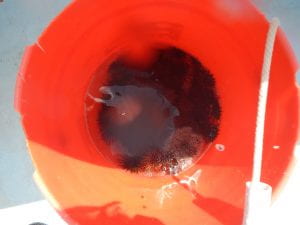We began the morning with a survey of sea urchins in patch reefs (in and out of marine-protected areas). We collected urchins in a bucket, then identified them by species and determined the diameters of their tests (in centimeters). We found long-spined urchins (Diadema antillarum) (don’t touch!), slate-pencil urchins (Eucidaris tribuloides), reef urchins (Echinometra viridis), and a few West Indian sea eggs (Tripneustes ventricosus). Although I was hesitant to jam my hand into small crevices in the coral to retrieve these spiny creatures, I had fun catching the urchins while simultaneously discovering how stubborn they can be. Some of those sea urchins were really wedged into their crevices and would not budge.
Bucket o’ urchins!
We collated our data into a poster, then transitioned into lectures on crustaceans, hydrozoa, cubozoa, scyphozoa, ctenophores, and climate change and its effect on coral reefs.
We ended the night with a night snorkeling session from the dock to a patch reef nearby (which we got lost on the way to). It was a surreal experience. In the brief time that we were out in the water, I did not get to see much, but the creatures that I saw —including some tasty-looking lobsters—were vastly different from the ones that I normally see during the day. Our limited field of vision under water made for an invigorating experience, like when sting rays appeared and disappeared from darkness.

